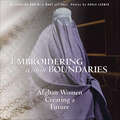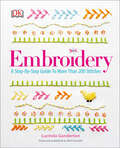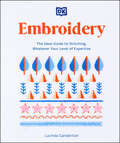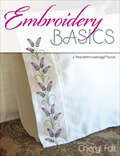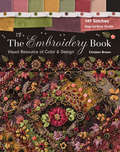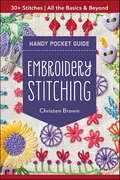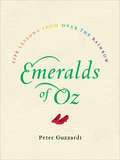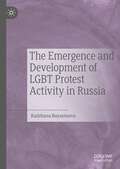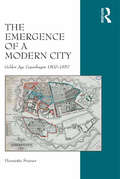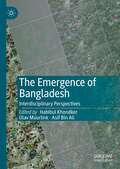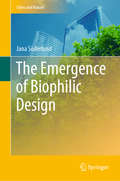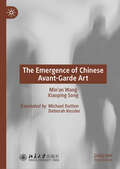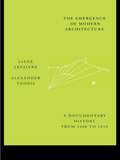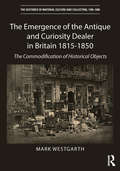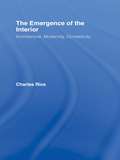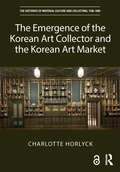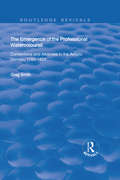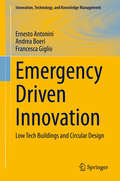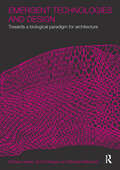- Table View
- List View
Embroidering within Boundaries: Afghan Women Creating a Future
by Rangina HamidiWinner, Silver Medal in the Multicultural Category, 2018 IBPA Benjamin Franklin Awards Fifteen years ago, Rangina Hamidi decided to dedicate her life to helping rebuild her native Kandahar, Afghanistan. The Taliban had been driven out by American forces following 9/11, but Kandahar was a shambles. Tens of thousands of women, widowed by years of conflict, struggled to support themselves and their families. Rangina started an entrepreneurial enterprise, using the exquisite traditional embroidery of Kandahar, to help women work within the cultural boundaries of Pashtunwali to earn their living and to find a degree of self-determination. Thus Kandahar Treasure was born. This book traces the converging paths of traditional khamak embroidery and the 300 brave women who have found in it a way to build their lives. The late, award-winning photojournalist Paula Lerner was dedicated to telling the stories of women in Afghanistan. Her remarkable images throughout the book show Afghan women's profound struggle, strength, and beauty.
Embroidery: A Step-by-Step Guide to More than 200 Stitches
by DKThe ultimate stitch dictionary, perfect for anyone who wants to learn and master the traditional craft of embroidery! A visual encyclopedia of stitches that will inspire and inform sewers of all levels. With this comprehensive guide in hand, you'll be able to accomplish and perfect every stitch under the sun! This handbook is packed with practical advice on which thread, needles or fabrics work best with different techniques. From looped and tied needlepoint stitches to open and solid filling stitches, you&’ll learn how to complete over 200 incredible stitches in no time. This practical embroidery book covers sewing tips for dressmaking, needle point and embroidery stitches. Learn the art quickly with concise text, close-up photography and step-by-step instructions and illustrations. Finding the perfect stitch for your next sewing project is easy thanks to this comprehensive embroidery guide. Embroidery shows you that with just a few simple stitches, some basic materials and an idea or two, you can sew just about anything. High-quality photography, helpful captions and diagrams make the techniques achievable for beginners and provide an invaluable reference guide for experienced embroiderers. Join the Embroidery Revolution Although embroidery has been around for many years, this book will help you enjoy the craft in a fresh, fun and modern way. Whether you're already an expert, just starting out or looking for a new hobby at home, Embroidery gives you a detailed checklist of everything you&’ll need to embark on your stitch journey. Inside the pages of this illustrated guide from DK Books, you&’ll find: • Inspirational ideas and practical advice on stitches for embroidery, needlepoint and dressmaking. • Step-by-step instructions and clear photographs showing you how to achieve more than 200 stitches. • Everything you need to choose the right threads, needles and fabrics.
Embroidery: The Ideal Guide to Stitching, Whatever Your Level of Expertise
by Lucinda GandertonDK brings you an all-encompassing embroidery book on needlework, stitches and more! Whether you are an embroidery beginner wanting to learn the basics or an accomplished crafter seeking to perfect your technique, this all-encompassing embroidery stitch book has something for everyone to love!Embroidery Stitches Step-by-Step covers every aspect of the craft: materials and mounting techniques, fabrics and frames, along with more than 200 stitches illustrated and explained with easy-to-follow instructions. With an at-a-glance gallery to help you find the perfect stitch for your next project, this tried-and-trusted modern classic is a must-have for stitchers of all ages and abilities.Dive straight in to discover: - Over 200 decorative stitches with practical ideas on where to use them- A comprehensive stitch gallery allowing readers to quickly find the stitches they&’re interested in - Featuring several handy how-to guides and basic embroidery considerations for beginners Full of top tips on which threads, needles and fabrics work best with which stitches, this design book is sure to unleash your potential and inspire your creativity like never before! Whether you are an embroidery beginner looking for a clear and easy-to-follow guide to a plethora of beautiful stitch types or an accomplished crafter seeking to perfect your technique and pattern design, this all-encompassing embroidery stitch book has something for everyone to love. From materials to mounting techniques, fabrics to frames, this easy-to-navigate needlework book has more than 200 stitches explained in excellent detail, with a practical stitch gallery providing readers with a clear view of each stitch, suitable for both beginners and proficient stitch enthusiasts. It&’s time to perfect your patterns and clean up your cross stitch with this embroidery starter kit that&’ll redefine textile art as you know it!At DK, we believe in the power of discovery. So whether you fancy taking up a new skill or simply find sanctuary in sewing, unleash your creativity and craftiness with this modern embroidery book.When you&’ve finished Embroidery Step By Step why not also try Sew Step by Step, a complementing title as part of DK&’s Step by Step series. Unleash your creative potential with a plethora of stunning stitches!Proving the perfect embroidery gift for the stitching lover in your life, embark on embroidery projects and create inspiring stitches to treasure forever. An inspirational and practical guide to more than 200 embroidery and needlepoint stitches.
Embroidery Basics: A NeedleKnowledge® Book
by Cheryl FallThis illustrated embroidery guide takes you step-by-step through seventeen projects using a variety of techniques, including forty-two stitches. Needlecraft designer Cheryl Fall offers the ideal guide for beginner and intermediate crafters who want to master embroidery stitches. A comprehensive and fully illustrated skill-building section is followed by fun and creative projects using both surface embroidery and counted-thread embroidery techniques. Embroidery Basics covers: · How to use a variety of embroidery threads and simple stitches to create beautiful embroidered projects · Seventeen projects in a wide variety of easy-to-learn techniques, with color patterns, including designs for towels, napkins, pillowcases, purses, cushions, tablet covers, ornaments, and samplers Guidelines and color illustrations for mastering forty-two stitches
The Embroidery Book: Visual Resource of Color & Design
by Christen Brown“A spectacular encyclopedia of embroidery, sharing valuable techniques passed down through the generations . . . you’ll wonder how you ever worked without it.” —Sew MagazineEnjoy the tranquility of slow stitching with this step-by-step, visual guide to 149 embroidery stitches, motifs, and extras. Go beyond basic color theory–robust color charts take the guesswork out of choosing thread, silk ribbon, buttons, beads, and trims. Then take your embroidery to the next level with luxurious seam treatments and stunning stand-alone designs. Bestselling author Christen Brown’s traditional and contemporary techniques are showcased in a colorful gallery of crazy-quilted projects.“An overview of embroidery stitches and techniques as well as inspiration for embroidery projects . . . She dissects several of her pieces, summarizing the color palette, decorative elements, and stitches used.” —Library Journal
Embroidery for the Absolute Beginner (Absolute Beginner Craft)
by Susie Johns Caroline SmithDiscover how to use traditional embroidery techniques from simple cross stitch to pulled thread embroidery—even if you’ve never embroidered before.The book introduces the reader to many different stitchery techniques from simple cross stitch to intricate pulled threadwork. Some of the techniques are useful for making decorative borders, while others are good for adding spot designs, monograms and lettering, and applying beads and sequins. There are twenty designs to choose from including motifs for attractive home accessories and a wide range of fashionable garments. Readers will also find out how the simplest of sewing machines can create embroidered pieces in a fraction of the time it takes to do it by hand.Everything is explained with clear, step-by-step photography and no-nonsense, easy-to-follow text.
Embroidery pour la Maison
by Sylvie BlondeauThis delightful little craft book from French artist Sylvie Blondeau presents more than 100 projects for adding charm to your everyday things. With decorating ideas for things you use all the time, such as your aprons, your bags, your recipe and address books, this easy-to-follow embroidery book teaches personalisation ideas for both first-time and experienced sewers. Using step-by-step text and illustrations, readers will learn twenty-one embroidery methods - les secrets de la broderie - so they can easily embroider every project in the book and add charm to objects in every room of the house - kitchen, bedroom, bathroom, living room, laundry room, office. In no time they'll be adding cupcakes to their dishtowels, teapots to cozies, telephones to address books, bubbles to bathrobes, baguettes and macarons to their shopping bags. At a very affordable £8. 99, this is the perfect impulse buy, present, and home decorating companion. It is part of a new Harper Design embroidery series and is dolled up in a petit and colorful package, with each project inside looking as if it has been hand-stitched directly into the book. For the ever-growing world of crafters - the mothers, grandmothers, and new generation of crafters on Etsy and Pinterest, the women personalizing things for themselves and gifts for their loved ones - the books they flock to are the most charming ones, and no other embroidery book is as deliciously charming, as inspire et enchante, and as easy-to-follow as this one.
Embroidery pour le Bébé
by Sylvie BlondeauIn Embroidery pour le Bebe, a delightful little craft book from French artist Sylvie Blondeau, you'll find more than 100 adorable ways to decorate everyday objects for babies. With decorating ideas for things they use all the time, such as diaper bags, blankies, bibs, bottle holders, and toys, this embroidery book includes projects for both first-time and experienced sewers. Embroidery pour le Bebe is filled with easy-to-follow, step-by-step illustrations and text for creating a nursery full of personalized presents for a new arrival. The first in a series of charming needlework books, Embroidery pour le Bebe is a must-have for mommies- and grandmothers-to-be, crafters, or anyone who is interested in adding a personal touch to that perfect new baby gift.
Embroidery pour le Jardinier
by Sylvie BlondeauThis delightful little craft book from French artist Sylvie Blondeau presents more than 100 projects to add nature motifs to all sorts of things used inside and outside the home. Through easy-to-follow, step-by-step instructions and a wealth of illustrations, new and experienced crafters will learn twenty-one embroidery methods—des secrets de la broderie—so they can easily embroider every project in the book. The charming motifs featured inside include things like strawberries, butterflies, chipmunks, and flowers. There are porcupines, cherries, pumpkins, and scarecrows. These lovely ideas can decorate all sorts of supplies, from tool and seed bags to gloves, pot covers, and smocks.
Embroidery Stitching Handy Pocket Guide: 30+ Stitches—All The Basics & Beyond
by Christen BrownGet the pocket guide to embroidery that everyone's talking about—a sixty-four page mini book that's perfect to take on the go! Keep your favorite stitches within reach, with this all-in-one reference for hand stitchers, crazy quilters, and free-form embroiderers. Learn the best stabilizers and thread for embroidery from expert Christen Brown, then branch out with embellishments, beads, and charms. This petite paperback is the perfect size for your purse or sewing kit. - Take it with you anywhere! Quick and easy reference to over thirty embroidery stitches—both starter stitches and more advanced combinations - Beef up your needlework know-how with expertise on everything from choosing threads to adding embellishments - Fall in love with embroidery all over again, and share this giftable guide with everyone you know who loves to sew "
Emeralds of Oz: Life Lessons from Over the Rainbow
by Peter GuzzardiPeter Guzzardi spent decades as an editor working with some of the wisest writers of our time—from Stephen Hawking and Deepak Chopra to Carol Burnett and Douglas Adams—yet he couldn’t shake the sense that everything he’d learned from working with them felt oddly familiar. One day, he had an epiphany: All that wisdom had its roots in a film he’d watched as a child—The Wizard of Oz.In Emeralds of Oz, Guzzardi invites us to join him on a journey through the classic film, unearthing gems of wisdom large and small about longing, joy, compassion, fear, power, and having faith in ourselves. He also creates a practical Oz-based tool that we can apply to obstacles in our own lives. Now, like Dorothy, we can activate the magical power we’ve possessed all along.Written with the grace and insight of All I Really Need to Know I Learned in Kindergarten, Emeralds of Oz is an instant classic, sure to inspire a fresh perspective on this legendary movie—and on our own lives.
The Emergence and Development of LGBT Protest Activity in Russia
by Radzhana BuyantuevaThis book draws on social movement theories and rich empirical data to analyze LGBT protest activity in Russia. It offers a critical examination of the conditions under which LGBT protest activity arises and declines in authoritarian states - including state repression and socio-political discrimination of LGBT people; policy changes that negatively affect the LGBT community; and the motivations of the activists themselves. The author argues that a combination of political opportunity structures, resources, and activists’ perceptions establish necessary conditions for protesting. If any of these factors are negatively affected, then LGBT activists would not be motivated to protest. The volume concludes with a discussion of the implications of Russian LGBT activism in hostile conditions. This book will be of interest to scholars engaged in human rights, social movement studies, gender studies, LGBT rights, and post-Soviet politics and societies.
Emergence in Interactive Art
by Jennifer SeevinckThis book is concerned with emergence, interaction, art and computing. It introduces a new focus for emergence in interactive art: the emergent experience. Emergence literature is discussed and an organising framework, the Taxonomy of Emergence in Interactive Art (TEIA) is provided together with case studies of digital, interactive art systems that facilitate emergence. Evidence from evaluations of people interacting with the works is analysed using the TEIA. Artworks from across the world are also reviewed to further illustrate the potential for emergence. Interactive art is, itself, still a young domain where audience influence, or interaction with the work is a defining aspect. Emergence in Interactive Art explores the rich opportunities for interactive experiences of digital art systems that are provided by looking through a 'lens' of emergence. And what better way to explore these potentials than through the open-ended domain of emergence, with its inherent affinity to the natural world? Through an integrated approach of practice, research and theory this book reveals design and analytical insights relating to emergence, interaction and interactive art to benefit artists, researchers and designers alike.
The Emergence of a Modern City: Golden Age Copenhagen 1800–1850
by Henriette SteinerThis book is an exploration of how urban life in Copenhagen, in the period known as the Golden Age (c. 1800 to 1850), was experienced and structured socially, institutionally, and architecturally. It draws on a broad historical source material - spanning urban anecdotes, biography, philosophy, literature, and visual culture - to do so. The book argues that Copenhagen emerged as a modern city at this time, despite the fact that the Golden Age never witnessed the appearance of the main characteristics of the modernisation of cities associated with industrialisation, such as street lighting, sewer systems, and railroads. The book outlines the historical and topographical context of Copenhagen in the Golden Age with a special focus on the works of the most prominent architect of the period, C.F. Hansen. The characterisation of the city is complemented by investigations into writings of three citizens: the philosopher Soren Kierkegaard, the novelist Thomasine Gyllembourg, and the criminal Ole Kollerod, who all take an interest in the city's institutional and urban structures as well as their own place in it. From these different sources, a picture is painted of urban life and thought at a time when the city began to take on characteristics of ambiguity and alienation in European thinking, while at the same time the city itself retained some pre-modern motifs of a symbolic order. This transformation is set in a larger process of cultural re-orientation, from traditional Baroque culture to what might be termed Romantic culture. The book reconsiders the significance of this transformation for the emergent order of the modern European city in the nineteenth century and thus of the very foundation on which our own urban culture rests.
The Emergence of Bangladesh: Interdisciplinary Perspectives
by Habibul Khondker Olav Muurlink Asif Bin AliThe Emergence of Bangladesh analyses and celebrates the first 50 years of Bangladesh as a nation, bringing insights from key scholars in Bangladeshi studies to an international audience, as well as ‘bringing home’ to a domestic audience the work of some of the nation’s greatest intellectual exports, the Bangladeshi scholars who have made a mark in their field of study in academia. The book offers unique coverage of the battlegrounds on which the founding of the new nation was fought, including language, power and religion, and provides unique insight into some of the hot spots that continue to shape the development of the nation: the issues of gender, culture, ethnicity, governance, the economy and the army. Those with an interest in understanding the past or present Bangladesh will find this a trove of frank and readable analysis.
The Emergence of Biophilic Design (Cities and Nature)
by Jana SöderlundThis book addresses the emergence of biophilic design, a form of design that looks at people’s intrinsic connection with nature. There is no denying that biophilic design is rapidly expanding globally as an effective response to pressing issues in urban areas and built environments. From being a term few had heard of in 2012, when the author’s research began, to one that is currently trending in a broad range of disciplines, the story of its emergence has never been properly told. The story of the emergence of biophilic design is the story of a social movement and how a gathering of people with a common interest and passion can spark a global trend. The book and the stories within are not only engaging but also informative and educational, offering readers an in-depth understanding of what biophilic design is all about, and how to promote its implementation in their own built environment. Hopefully, they will inspire people to act, to campaign and to implement initiatives in their urban environment, with the confidence that they are capable of making a difference. The author spent three years researching the emergence of biophilic design, and why and how it was driven by certain people who championed the concept. Part of the author’s research involved a three-month tour of ten North American cities, during which she interviewed 26 key players. These people ranged from community leaders, landscape architects, and academics, to the CEOs of NGOs and government leaders. The result is a collection of stories that illustrate the evolution of biophilic design, and how it was frequently born from a passion for, belief in and love of nature, as well as a response to an urban crisis.
The Emergence of Chinese Avant-Garde Art
by Min'an Wang Xiaoping SongThis book provides a historical analysis of the avant-garde art movement in China in the 1980s. This art movement is the product of China's reform and opening up, during which time a small number of Chinese artists understood the western modernist art movement, and they started their avant-garde art experiment in combination with the actual situation of China. This avant-garde art experiment completely broke all the artistic styles in Chinese history, and it caused a huge shock. After about a decade of radical attempts, it began to form its own position in China. This book discusses its birth background, its dominant artists and works, its theme and interest, and its final decline. This is not only a work of art history, but also a work of cultural history with strong sociological analysis. This book is beautiful in writing, detailed in analysis and highly readable. It is a very suitable book for those who want to know avant-garde art and Chinese since the 1980s.
The Emergence of Cinematic Time: Modernity, Contingency, the Archive
by Mary Ann DoaneHailed as the permanent record of fleeting moments, the cinema emerged at the turn of the nineteenth century as an unprecedented means of capturing time--and this at a moment when disciplines from physics to philosophy, and historical trends from industrialization to the expansion of capitalism, were transforming the very idea of time. In a work that itself captures and reconfigures the passing moments of art, history, and philosophy, Mary Ann Doane shows how the cinema, representing the singular instant of chance and ephemerality in the face of the increasing rationalization and standardization of the day, participated in the structuring of time and contingency in capitalist modernity. At this book's heart is the cinema's essential paradox: temporal continuity conveyed through "stopped time," the rapid succession of still frames or frozen images. Doane explores the role of this paradox, and of notions of the temporal indeterminacy and instability of an image, in shaping not just cinematic time but also modern ideas about continuity and discontinuity, archivability, contingency and determinism, and temporal irreversibility. A compelling meditation on the status of cinematic knowledge, her book is also an inquiry into the very heart and soul of modernity.
The Emergence of Modern Architecture: A Documentary History, from 1000 to 1810
by Liane Lefaivre Alexander TzonisA cognitive history of the emergence of modern architecture. Cutting across disciplinarian and institutional divisions as we know them today, this book reconstructs developments within the framework of a cognitive history of the past. Modern is here taken to mean the radical re-thinking of architecture from the end of the tenth century in Europe to the end of the eighteenth century. Among the key debates that mark the period are those that oppose tradition to innovation, canon to discovery, geometrical formality to natural picturesqueness, the functional to the hedonistic.
The Emergence of the Antique and Curiosity Dealer in Britain 1815-1850: The Commodification of Historical Objects (The Histories of Material Culture and Collecting, 1700-1950)
by Mark WestgarthRather than the customary focus on the activities of individual collectors, The Emergence of the Antique and Curiosity Dealer in Britain 1815–1850: The Commodification of Historical Objects illuminates the less-studied roles played by dealers in the nineteenthcentury antique and curiosity markets. Set against the recent ‘art market turn’ in scholarly literature, this volume examines the role, activities, agency and influence of antique and curiosity dealers as they emerged in the opening decades of the nineteenth century. This study begins at the end of the Napoleonic Wars, when dealers began their wholesale importations of historical objects; it closes during the 1850s, after which the trade became increasingly specialised, reflecting the rise of historical museums such as the South Kensington Museum (V&A). Focusing on the archive of the early nineteenth-century London dealer John Coleman Isaac (c.1803–1887), as well as drawing on a wide range of other archival and contextual material, Mark Westgarth considers the emergence of the dealer in relation to a broad historical and cultural landscape. The emergence of the antique and curiosity dealer was part of the rapid economic, social, political and cultural change of early nineteenth-century Britain, centred around ideas of antiquarianism, the commercialisation of culture and a distinctive and evolving interest in historical objects. This book will be of interest to scholars in art history, histories of collecting, museum and heritage studies and nineteenth-century culture.
The Emergence of the Interior: Architecture, Modernity, Domesticity
by Charles RiceTaking a radical position counter to many previous histories and theories of the interior, domesticity and the home, The Emergence of the Interior considers how the concept and experience of the domestic interior have been formed from the beginning of the nineteenth century. It considers the interior's emergence in relation to the thinking of Walter Benjamin and Sigmund Freud, and, through case studies, in architecture's trajectories toward modernism. The book argues that the interior emerged with a sense of 'doubleness', being understood and experienced as both a spatial and an image-based condition. Incorporating perspectives from architecture, critical history and theory, and psychoanalysis, The Emergence of the Interior will be of interest to academics and students of the history and theory of architecture and design, social history, and cultural studies.
The Emergence of the Korean Art Collector and the Korean Art Market (The Histories of Material Culture and Collecting, 1700-1950)
by Charlotte HorlyckArticulating the shifting interests in Korean art and offering new ways of conceiving the biases that initiated and impacted its collecting, this book traces the rise of the modern Korean art market from its formative period in the 1870s through to its peak and subsequent decline in the 1930s.The discussion centres on the collecting of Koryŏ celadon ceramics as they formed the focal point of commercial exchanges of Korean artefacts and explores how their acquisition and ownership formed part of the complex power relationship that played out between the Koreans, Japanese, Americans, and Europeans. Drawing on a wide range of primary sources, the volume analyses collectors’ acquisition practices, arguing that their fascination with ceramics from the Koryŏ kingdom (918–1392) was shaped not only by the aesthetic appeal of the objects but also by biased perceptions of the Korean peninsula, its history, and people.The book will be of interest to scholars working in art history, social history, cultural history, Korean studies, collection studies, museum studies, Korean history, and Asian studies.
The Emergence of the Professional Watercolourist: Contentions and Alliances in the Artistic Domain, 1760–1824 (Routledge Revivals)
by Greg SmithThis title was first published in 2002: Draw ing on extensive primary research, Greg Smith describes the shifting cultural identities of the English watercolour, and the English watercolourist, at the end of the eighteenth and the beginning of the nineteenth century. His convincing narrative of the conflicts and alliances that marked the history of the medium and its practitioners during this period includes careful detail about the broader artistic context within which watercolours were produced, acquired and discussed. Smith calls into question many of the received assumptions about the history of watercolour painting. His account exposes the unsatisfactory nature of the traditional narrative of watercolour painting’s development into a ’high’ art form, which has tended to offer a celebratory focus on the innovations and genius of individual practitioners such as Turner and Girtin, rather than detailing the anxieties and aspirations that characterized the ambivalent status of the watercolourist. The Emergence of the Professional Watercolourist is published with the assistance of the Paul Mellon Foundation.
Emergency Driven Innovation: Low Tech Buildings and Circular Design (Innovation, Technology, and Knowledge Management)
by Ernesto Antonini Andrea Boeri Francesca GiglioThis book explores the relationship between the circular economy and the building technologies within the quintuple helix innovation model. The main question the book answers is whether and how the conversion of sustainable construction processes can be a powerful engine of innovation for the industry. The post-disaster settlements and temporary shelters are assumed as examples of what can be defined as circular buildings in regards to the technical arrangements and features, material and process reversibility, as the social and participative dimensions.Several cases of these interventions are documented and classified by three thematic axes: design, building and living. This highlighted new trajectories for innovation in building technology, consistent with the social, economic and productive dynamics that no longer allows for growing performance by increasing the resource demand. A theoretic framework is traced supporting this vision, which shows how the low technologies can respond to the transition of the economic model from linear to circular. Within this trajectory, the low-tech design for remanufacturing represents a reference framework and a promising tool applicable to the building processes.The enabling technologies and new paradigms for the transition to circular economy emerging from the European research scenario are also mapped, outlining z`the possible future developments in line with open technical and societal challenges.
Emergent Technologies and Design: Towards a Biological Paradigm for Architecture
by Michael Hensel Achim Menges Michael WeinstockEmergence - the process by which new and coherent structures, patterns and properties ‘emerge’ from within complex systems Traditional architecture starts from the premise that architectural structures are singular and fixed, and however well integrated are separate from their environment and context. Emergence requires that the opposite is true – that those structures are complex energy and material systems that have a lifespan, exist as part of an environment of other active systems, and develop in an evolutionary way. This book, based on the authors’ internationally renowned Emergent Technologies and Design course at the Architectural Association in London, introduces a new approach to the practice of architecture. The authors use essays and projects to demonstrate the interrelationship of concepts such as emergence and self-organisation with the latest technologies in design, manufacturing and construction. With projects from their course, and critiques and commentary from some of the world’s leading design theorists and practitioners, the authors of Emergent Technologies and Design have introduced a radical new way of understanding the way in which architecture is conceived, designed and produced.
